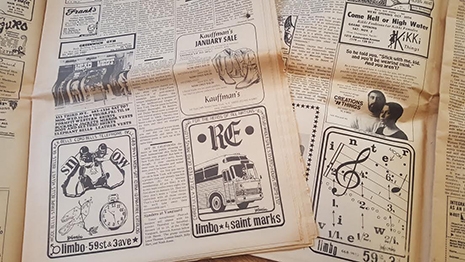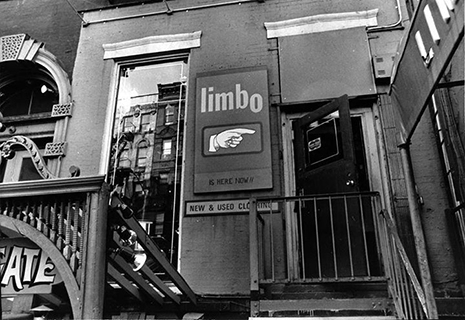
It all started a few weeks ago with a nice lady dropping by the record store with two cardboard moving boxes full of old newspapers. “I thought I’d see if anyone here wanted these before I threw them out.”
I looked into the first box and on top was an issue of The Village Voice from April of 1969. Without even hesitating I said “Yep, I’ll be happy to take these in.” Digging further, I saw that I was looking at two boxes full of old Voice issues from the late ‘60s—mega score. All I had in my pocket was ten dollars, but I offered it to the nice lady. “These are cool, please take my ten bucks. And THANK YOU!”
I started plowing through the contents of the two boxes when I got home that evening. All tolled, there were forty-five issues of the Voice dating between 1967 and 1969—one of the most interesting periods in U.S. history for art and radical politics. The Voice, at that time, was one of the major mediums carrying the anti-war message, not to mention reporting on the explosion of art, psychedelic thought, and counterculture. Every issue in those two boxes was a treasure trove of Vietnam era cool: Andy Warhol shot. Abbie Hoffman arrested. Eldridge Cleaver lecturing. Burroughs and Ginsberg hit up Timothy Leary’s LSD Center. Jimi Hendrix is playing this weekend. Janis Joplin is playing another. Hair is on Broadway. I Am Curious (Yellow) is at the cinema. EVERYONE is protesting. Cops are busting heads. I’m completely enthralled and lost in these stacks.
As I’m meticulously poring over the issues, I begin to notice the ads for one particular shop: Limbo. To say there was something special about these mystifying “anti-ads” is an understatement. My eye was drawn magnetically to the Limbo graphics. There was at least one in every issue. The designs were sort of a Dada/Pop Art hybrid, but actually quite unlike anything else—definitely unlike anything else in the Voice at that time. Sure, there were lots of era-typical psychedelic graphics advertising everything from fur coats to futons… but the Limbo ads weren’t exactly psychedelic… and they weren’t exactly advertising anything other than their own unique form. They seemed completely and beautifully out of place and time, something a step beyond the pop iconography of Warhol’s work from a few years prior. Familiar, yet obscure. Every image stopped me in my tracks and had me guessing at its mysteries.

Ads for Limbo as they appeared in the Village Voice.
I became obsessed. I went through every issue, specifically hunting each Limbo ad. They were all different. They didn’t repeat. All arresting and confounding.

Mesmerized, curious, needing to know more, I went to the Internet for information and with very little effort found that this long-defunct shop had both a handy Wikipedia entry and Facebook presence.
From what I discovered, I was surprised I hadn’t already known about Limbo. It was apparently the IT shop in the East Village. Writing in eye Magazine, Norman Steinberg described Limbo as “much more than just a clothing store. It is a social, intellectual, and entertainment experience that appeals to people of all ages, races, creeds, colors and political persuasions.”
Beyond being simply a retail shop, Limbo was a countercultural HUB for disaffected New Yorkers. The store, through a wholesale sales agreement with Fillmore East, dressed rock stars from Janis Joplin, Jimi Hendrix and Jim Morrison, to the New York Dolls and Velvet Underground. John Lennon, Yoko Ono, Andy Warhol and his “superstars” Baby Jane Holzer, Nico, Viva and Edie Sedgwick were all frequenters.

“Dress as decoration. Dress as defiance. Dress as decorum, or its opposite. That was at the heart of Limbo.”
Limbo sold not only typical “peacenik” clothes like Indian cottons and silks, but also military surplus for the Yippie warriors of the day. Limbo was one of the first sellers to make “vintage” clothing “hip,” calling the inventory on their flyers: “Dead Man’s Clothing.” Limbo is also often credited with starting the trend of “distressing” blue jeans before sale. As a retail shop, it served as a cultural focal point in the East Village—much in the same way that its successor served the early punk scene. Many of our readers may be familiar with the store which Limbo became after being sold in 1975: Trash & Vaudeville.

“Carefully Selected Dead Men’s Clothing For The Heads of All Nations”
As I thought about the notion of a shop like Limbo being a community axis, I was reminded of my own recent experience with the nice lady dropping off the two boxes of Village Voices at the record shop and felt connected to that tradition of storefronts being places that can exist beyond their capitalist function of exchanging goods and services for money—places that offer a space for like-minded individuals to meet and share ideas or pass things along simply because that’s a “cool thing to do.”
Scouring the photo galleries on Limbo’s Facebook page, I found many of the same striking ads I had seen in those Village Voice issues. Scanning through those, I located the name of the artist who had designed them: Ira Kennedy.
Much more after the jump…





